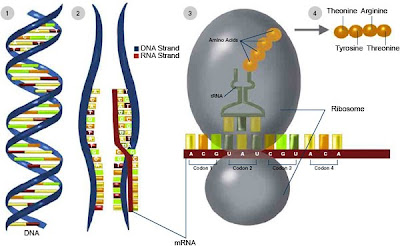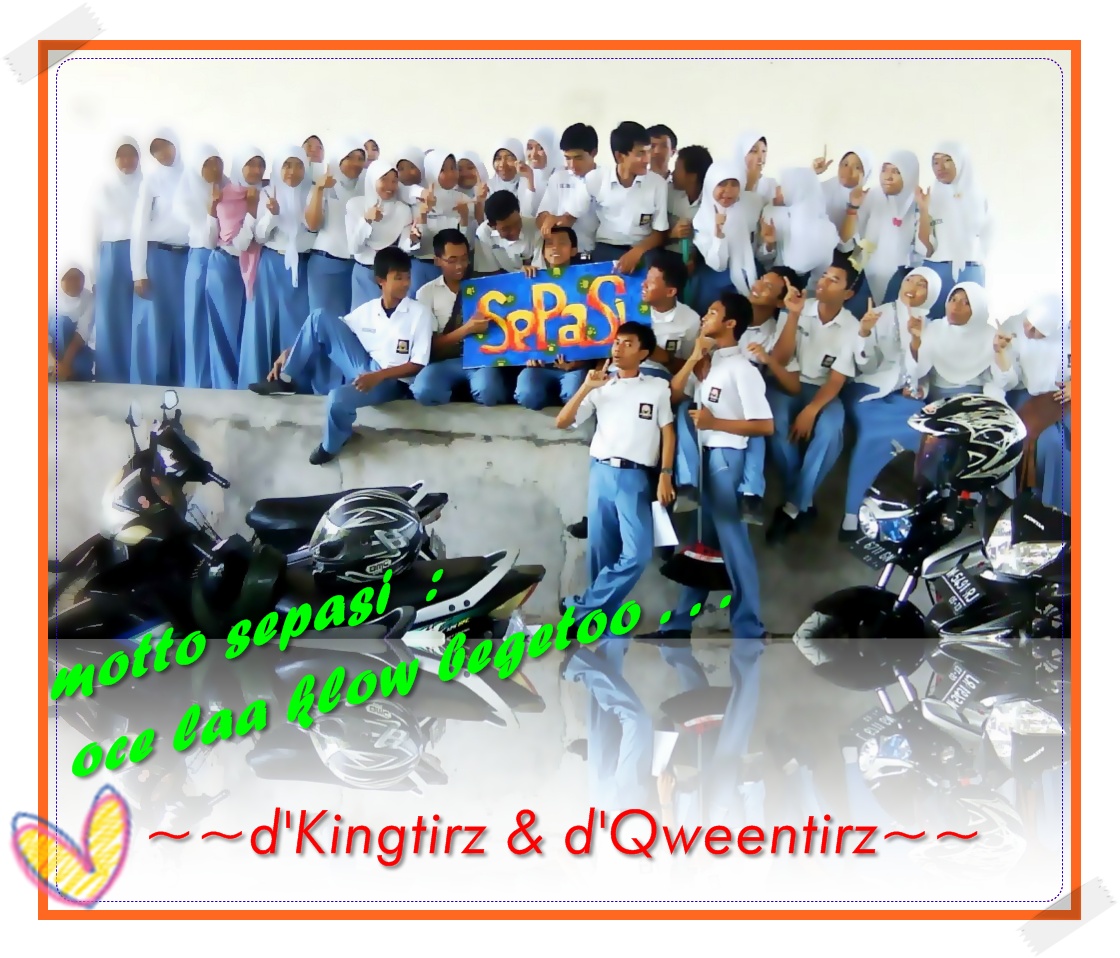
Genes
Genes are sections of DNA. A single gene consist of a length of DNA that codes for one specific protein. This is sometimes referred to as one gene – one protein – one job.
What is DNA?
DNA is often referred to as a polynucleotide. This is because it is made up from single unit called nucleotides.
a nucleotide is made up from one of four bases, attached to a pentose sugar (it has 5 carbon atoms), and a phosphate. There are four different bases:
1. Adenine [A]
2. Thymine [T]
3. Cytosine [C]
4. Guanine [G]
These four bases are the four letters of the genetic alphabet. The nucleotides are joined together in pairs. The base of each pair is joined by a hydrogen bond.
What does DNA do?
DNA has two different jobs:
1. It provides the code for all the instructions needed to make a living organism.
The code consists of a language using only 4 letters. Using only combinations of 4 letters (bases), the code has to be very long. A single instruction to make a protein may have several thousand letters. Each human being has enough DNA to stretch to the moon. Because DNA is double stranded, only one strand is the actual code. It is called the sense strand
2. It has to copy itself (replication) so that at cell division all new cells have a copy of the complete set of instructions.
Every time a cell divides, each new cell must receive a copy of the DNA. This means that during lifetime DNA gets copied thousands of times. Whenever errors occur in the structure of the, they are copied when the DNA is replicated. These errors are called mutations.
How does DNA replicated?
For a long time, scientists were not sure how DNA replicated. Did it make a complete copy of itself, in one go? –the conservative method. or did it make a copy of just one single strand each time the cell divided? – The semi-conservative method. Eventually they discovered it was the semi-conservative method
Gene Technology
Many modern genetic processes require large amounts of DNA. The polymerase chain reaction is a method of producing large amounts of DNA from a single DNA molecule. For example, s scene of crime investigation may find only small quantities of DNA. The procedure can be used to provide larger quantities to carry out genetic fingerprinting tests.
1. DNA is heated to 95°C for 30 seconds. This causes the two strands to separate by breaking the hydrogen bonds between the bases.
The DNA is mixed with:
a. a solution containing all for bases, A, T, C, and G.
b. the enzymes DNA polymerase
c. short lengths of RNA called primers – these bind with the single strand and act as a trigger to start the copying process.
2. DNA rapidly cooled to 37°C for 30 seconds. This causes primers to bind to complementary strands of DNA.
3. DNA heated to 72°C for 2 minutes. This is the optimum temperature for DNA polymerase. New strands of DNA are made.
4. The cycle is repeated. Each cycle doubles the number of DNA molecules that can be used as templates for the next cycle.
Copying Genes
The process is now fully automates using a PCR machine. After only 25 cycle, more than 1 million copies of DNA can be produced from a single strand of DNA.
PCR can be used to provide DNA for electrophoresis and for determining the sequence of the bases in DNA.
The Human Genome Project has now deciphered the whole the human genome.
Genetic Engineering
All living organisms on the planet use DNA as a code to produce life. Unlike human languages used for communication, there is only one language in DNA and all living organisms use it. This means that any other organism will decode any DNA taken from one organism. A tortoise will understand the DNA from a rose and vice versa.
There does not seem to be much point in putting tortoise DNA into a rose. In some cases, however, putting DNA from one organism into another can be very useful.
The Insulin Story
Some people cannot make their own insulin, the hormone that controls levels of sugar in the blood. The condition is known as diabetes.
Many diabetics can survive only by having daily injections of the insulin. The insulin used to be obtained from animals. This was very expensive and some people became allergic to animal insulin. If they couldn’t use the insulin, they would die. Genetic engineering enables scientists to produce large quantities of human insulin very cheaply.
1. Normal human DNA is extracted, containing the gene for making insulin.
2. The insulin gene is cut out using an enzyme called a restriction enzyme.
3. The same restriction is used to cut open the DNA in a bacterial plasmid – a small ring of DNA in addition to the normal DNA strand found in bacteria.
4. The human insulin gene is inserted into the plasmid. The ends of DNA are rejoined using an enzyme called a ligase.
5. The bacteria are then allowed to multiply by growing and dividing in fermented. Millions of copies of the bacteria are made, all containing the human insulin gene.
6. The gene then starts to produce human insulin, which can be harvested.
Genetic Markers
Scientist sometimes wants to know which bacteria have been successful in taking up the gene. One way they can do this is to use genetic marker. Some plasmids contain a gene that makes the bacteria resistant to particular antibiotics. These genes can be used as genetic markers.
1. This plasmid has two antibiotic resistance genes, one for tetracycline and one for ampicillin. The insulin gene can be inserted in the middle of the ampicillin gene.
2. The bacteria are then grown on a culture medium in a Petri dish. The bacteria grow to form colonies, which are visible to the naked eye. Colonies that contain the insulin gene are colored red but in reality, the scientist would not know which colonies contained the insulin gene.
3. A piece of filter paper can be placed on top of the first Petri dish and then transferred to a second dish, producing an exact copy of the position of each culture. This time, however, the nutrient agar contains the antibiotic tetracycline. It destroys all those bacteria not resistant to tetracycline. All the insulin-containing bacteria will survive.
4. The same process is repeated onto another Petri dish. This is called replica plating. This time the agar contains the antibiotic ampicillin. This will kill all those bacteria that do contain the insulin gene. By comparing plates 2 and 3, the scientist can determine which bacterial colonies contain the human insulin gene.
Large-scale culturing
The bacteria that have been identified as containing the insulin gene can then be cultured in a fermentation vessel on a large-scale to produce marketable quantities of the human hormone, insulin.
Many other products, such as antibiotics, hormones and enzymes, can also be made using this process. Even food such as single-cell protein (SCP) can be made as a cattle food. Conditions such as temperature, pH and aeration need to be kept constant. The culture may be run continuously, with the product being harvested and new nutrient being fed into the mixture.
Gene therapy
Genetic disease
Cystic fibrosis is a genetic disease. It is caused by a mutation of base 1627 in the cystic fibrosis gene. The mutation results in a missing amino acid from a protein called the CFTR protein.
Normal CFTR protein
CFTR protein is found in cell membranes. its job is to transport chloride ions out of the cell, trough the cell membrane.
Faulty CFTR protein
When the protein is faulty, it can no longer transport chloride ions out of the cell. This cause water to enter the cell from outside the membrane by osmosis. The mucus on the outside of the membrane loses water and thickens. The thick mucus cause breathing problems and infections. it also blocks the ducts of the digestive glands and reproductive ducts, causing sterility
The solution
A cold virus is a microorganism that works by injecting its DNA into the cells of our respiratory tract. The virus DNA instructs our own DNA to stop working and to make more copies of the virus instead. We actually end up making the viruses that are going to make us ill. Scientist can use viruses to get useful DNA into cells. The virus that does this is called a vector. First, the viral DNA is destroyed and the new CFTR gene inserted into the virus. The method used is the same on that is used on bacterial plasmids.
Another solution
Another way that the new gene can be placed into the cells is is to wrap the gene inside lipid molecules. Because the plasma membrane is a phospholipids sandwich, lipid molecules can pass easily across the membrane. The new gene can be carried across the membrane by the lipid molecules.
How gene therapy can help treat cystic fibrosis
Cystic fibrosis is a hard disease to treat. Every single cell of the person’s body carries the faulty genes. It is impossible to repair the DNA of every single cell. However, the faulty gene more adversely affects some cells than others do. If the epithelial cells lining the breathing tubes could be repaired, the quality of life would be significantly improved. This type of treatment is called gene therapy. The problem, however, is how to get the new DNA into the cells of the respiratory tract. One method that is being trialed is to use an aerosol containing viral vectors.
Genetically modified animals
Organisms that contain genes from different organisms are called transgenic. Some transgenic sheep have been produced that contain the human gene for making alpha-1 antitrypsin. This enzyme helps to protect the lungs of the human from damage during an infection. It is very useful to be able to give this enzyme to patients who suffer from cystic fibrosis or other lung diseases such as emphysema.
How the sheep were genetically modified
The only way to produce transgenic animals is to insert the new gene into the cell that forms the zygote. When the zygote divides, the new gene is copied into every single cells of the organism. The picture shows a micro-needle about to inject new DNA into the zygote of a sheep. The zygote is being held on the end of a micropipette.
The ethical issues of genetic engineering
Candidates are expected to be able to discuss the ethical and moral issues involved in genetic engineering. Here are some of the questions that arise.
If we can save lives by curing diseases such as cystic fibrosis, should we not use the knowledge?
Is it right to change the DNA of crops such as wheat just to make them resistant to particular kind of weed killer?
Rice does not contain vitamin E. people who eat mainly rice can go blind because of a lack of the vitamin. A strain of GM rice now exists that contains the vitamin A gene from a carrot people who eat the rice no longer go blind. Should scientists be allowed to do this?
Big companies are getting the patents to any gene that they discover. Other scientists will have to pay if they wish to use this gene. Is it right that someone should be able to patent our DNA or should the knowledge belong in the public domain?



